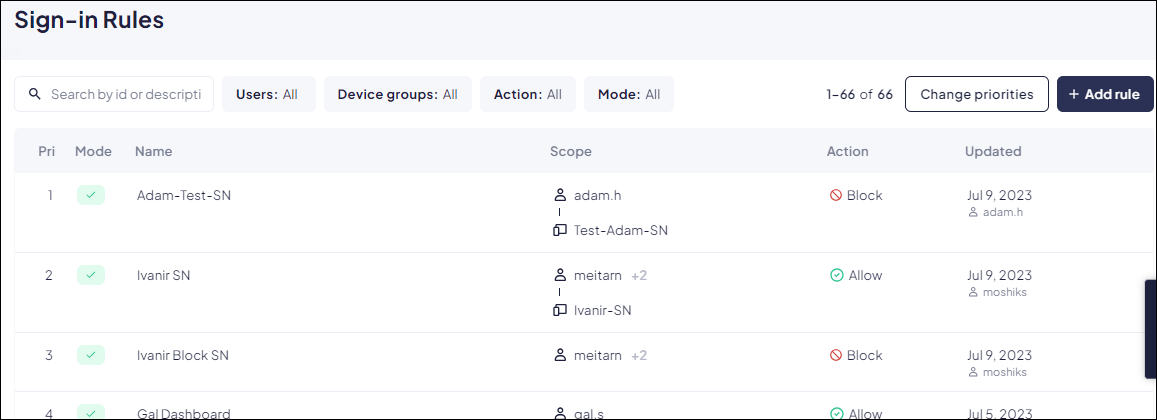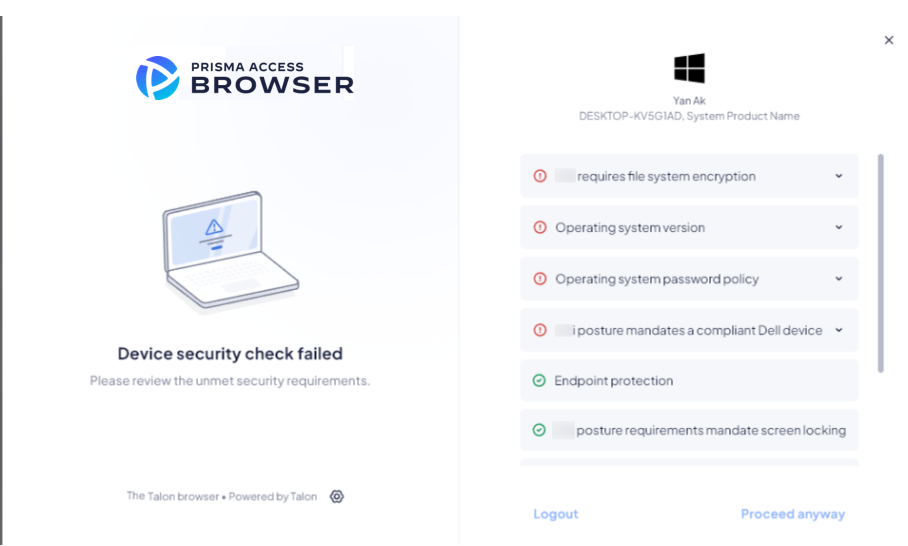Prisma Browser
Manage Prisma Browser Sign-in Rules
Table of Contents
Expand All
|
Collapse All
Prisma Browser Docs
Manage Prisma Browser Sign-in Rules
Learn how to create browser sign-in rules as a first level of securing your Prisma Browser deployment.
| Where Can I Use This? | What Do I Need? |
|---|---|
|
|
Use sign-in rules to determine which users and devices have access to Prisma Browser. The Sign-in rules page displays information about existing
sign-in rules:
To view the rules:The last rule on the
list is the Default rule.
The Default rule is the policy rule that is used
when no other policy rule is applicable. Since this rule must be available for
any given user or device, only certain controls can be edited.
- Priority—The priority order for rule enforcement.
- Mode—Indicates whether the rule is active or disabled.
- Name—Identifies and describes the rule.
- Users—The users and user groups associated the each rule.
- Device groups—The device group associated the each rule.
- Network & Location—The specific networks and geolocations associated with the rule.
- Action—The action Prisma Browser takes for users and devices matching the rule: Allow, Block, or Prompt the user.
- Updated—Last updated date for the rule; hover to see the full timestamp.

When you create a sign-in rule, you define the scope of the rule. When a user
attempts to access Prisma Browser, the browser compares the scope of the rules
in order until it finds a rule match for the user or device or network or
geolocation, and then it enforces the corresponding access rule. In some cases, you
may want the sign-in rules you define to block Prisma Browser if they match the
scope of the rule. For example, suppose the scope of the rule is set to match a
device group for devices with a specific OS and you don’t want to allow access to
devices that are still running that OS. In that case, you would set the sign-in rule
to block access for users who match to it. In other cases, you might want to allow
users who match the sign-in rule access to Prisma Browser. For example, suppose
the scope of the rule allows users in a specific user group and in a device group
that only allows devices running a specific OS version, a specific client
certificate, and has active endpoint protection. In this case, you might want the
matching sign-in rule to allow access to Prisma Browser. The way you create your
user groups and device groups (including the corresponding device posture rules you
enforce at the device group level) informs how you will want to create your sign-in
rules.
When a user attempts to access the browser, Prisma Browser
evaluates the sign-in rules in top-down order until it finds a match for the user
and device and then it enforces the corresponding sign-in rule. If the user or
device don’t match any of the defined sign-in rules, Prisma Browser enforces the
Default sign-in rule allow rule.
There are two
ways to create sign-in rules: one for managed devices and one for unmanaged devices,
as described in the following sections.
Create a Sign-in Rule
- Select ConfigurationPrisma BrowserPolicySign-in Rules and click Add rule.Enter a Name for the rule.Set an Action, which can be Active or Disabled.You can change the Action at any time. You may want to keep the rule disabled until you're ready to launch the new rule base.Click Next: Scope and then define the match criteria for the rule.Select one or more values to define the scope of the sign-in rule. You can select one or more of the following options:
- Users/User groups—Select the users and user groups that you want to match this sign-in rule to access Prisma Browser.
- Device groups—Select the device groups to match this sign-in rule for access to .. The device groups can contain posture attributes that are either positive or negative. For more information, refer to Device Posture Attributes.
- Networks—Select the public networks the device must be attached to in order to access Prisma Browser. Use one of the following formats to specify the network: 94.45.21.1 or 129.144.9.8/29
- Location – Select the geolocation from which to enable the Prisma Browser rule. If the OS Location services are not enabled on the device, the PAB will use the GeoIP. For more information, refer to Location-based Policy
![]() Click Next: Action.Set the action for the sign-in rule:
Click Next: Action.Set the action for the sign-in rule:- Allow—Allow access to Prisma Browser for users and devices that match the defined rule scope.
- Block—Block access to Prisma Browser for users and devices that match the defined rule scope.
- Prompt—Notify users that match the sign-in
rule scope that their Prisma Browser is blocked by default, but
allow them to bypass the block and continue to the browser. While the Prisma Browser for Mobile's Sign-in rules are configured the same way as the Sign-in rules for the Prisma Browser, be aware of the following exception:Starting with iOS browser version 1.4259 and Android browser version 1.4260, the Prompt action functions as Block. For all earlier versions, it functions as Allow.
![]() Optional) Create a browser customization rule for the device group.Provide text in the customization rule to help the user understand the posture errors (on the Security checks tab).
Optional) Create a browser customization rule for the device group.Provide text in the customization rule to help the user understand the posture errors (on the Security checks tab).![]() Save the rule.
Save the rule.



